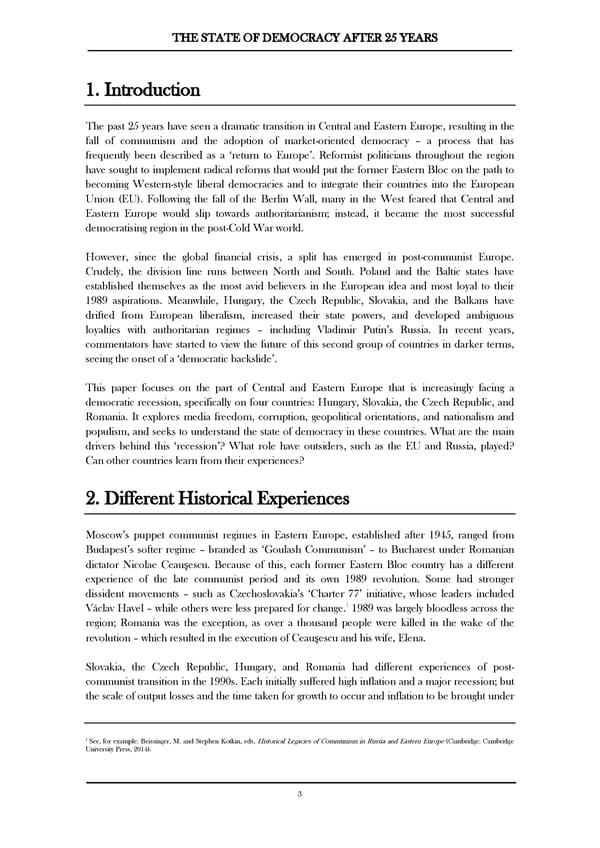THE STATE OF DEMOCRACY AFTER 25 YEARS 1. Introduction The past 25 years have seen a dramatic transition in Central and Eastern Europe, resulting in the fall of communism and the adoption of market-oriented democracy – a process that has frequently been described as a ‘return to Europe’. Reformist politicians throughout the region have sought to implement radical reforms that would put the former Eastern Bloc on the path to becoming Western-style liberal democracies and to integrate their countries into the European Union (EU). Following the fall of the Berlin Wall, many in the West feared that Central and Eastern Europe would slip towards authoritarianism; instead, it became the most successful democratising region in the post-Cold War world. However, since the global financial crisis, a split has emerged in post-communist Europe. Crudely, the division line runs between North and South. Poland and the Baltic states have established themselves as the most avid believers in the European idea and most loyal to their 1989 aspirations. Meanwhile, Hungary, the Czech Republic, Slovakia, and the Balkans have drifted from European liberalism, increased their state powers, and developed ambiguous loyalties with authoritarian regimes – including Vladimir Putin’s Russia. In recent years, commentators have started to view the future of this second group of countries in darker terms, seeing the onset of a ‘democratic backslide’. This paper focuses on the part of Central and Eastern Europe that is increasingly facing a democratic recession, specifically on four countries: Hungary, Slovakia, the Czech Republic, and Romania. It explores media freedom, corruption, geopolitical orientations, and nationalism and populism, and seeks to understand the state of democracy in these countries. What are the main drivers behind this ‘recession’? What role have outsiders, such as the EU and Russia, played? Can other countries learn from their experiences? 2. Different Historical Experiences Moscow’s puppet communist regimes in Eastern Europe, established after 1945, ranged from Budapest’s softer regime – branded as ‘Goulash Communism’ – to Bucharest under Romanian dictator Nicolae Ceauúescu. Because of this, each former Eastern Bloc country has a different experience of the late communist period and its own 1989 revolution. Some had stronger dissident movements – such as Czechoslovakia’s ‘Charter 77’ initiative, whose leaders included Václav Havel – while others were less prepared for change.1 1989 was largely bloodless across the region; Romania was the exception, as over a thousand people were killed in the wake of the revolution – which resulted in the execution of Ceauúescu and his wife, Elena. Slovakia, the Czech Republic, Hungary, and Romania had different experiences of post- communist transition in the 1990s. Each initially suffered high inflation and a major recession; but the scale of output losses and the time taken for growth to occur and inflation to be brought under 1 See, for example: Beissinger, M. and Stephen Kotkin, eds, Historical Legacies of Communism in Russia and Eastern Europe (Cambridge: Cambridge University Press, 2014). 3
 The State of Democracy After 25 Years Page 3 Page 5
The State of Democracy After 25 Years Page 3 Page 5